2009 TOYOTA 4RUNNER overheating
[x] Cancel search: overheatingPage 137 of 520
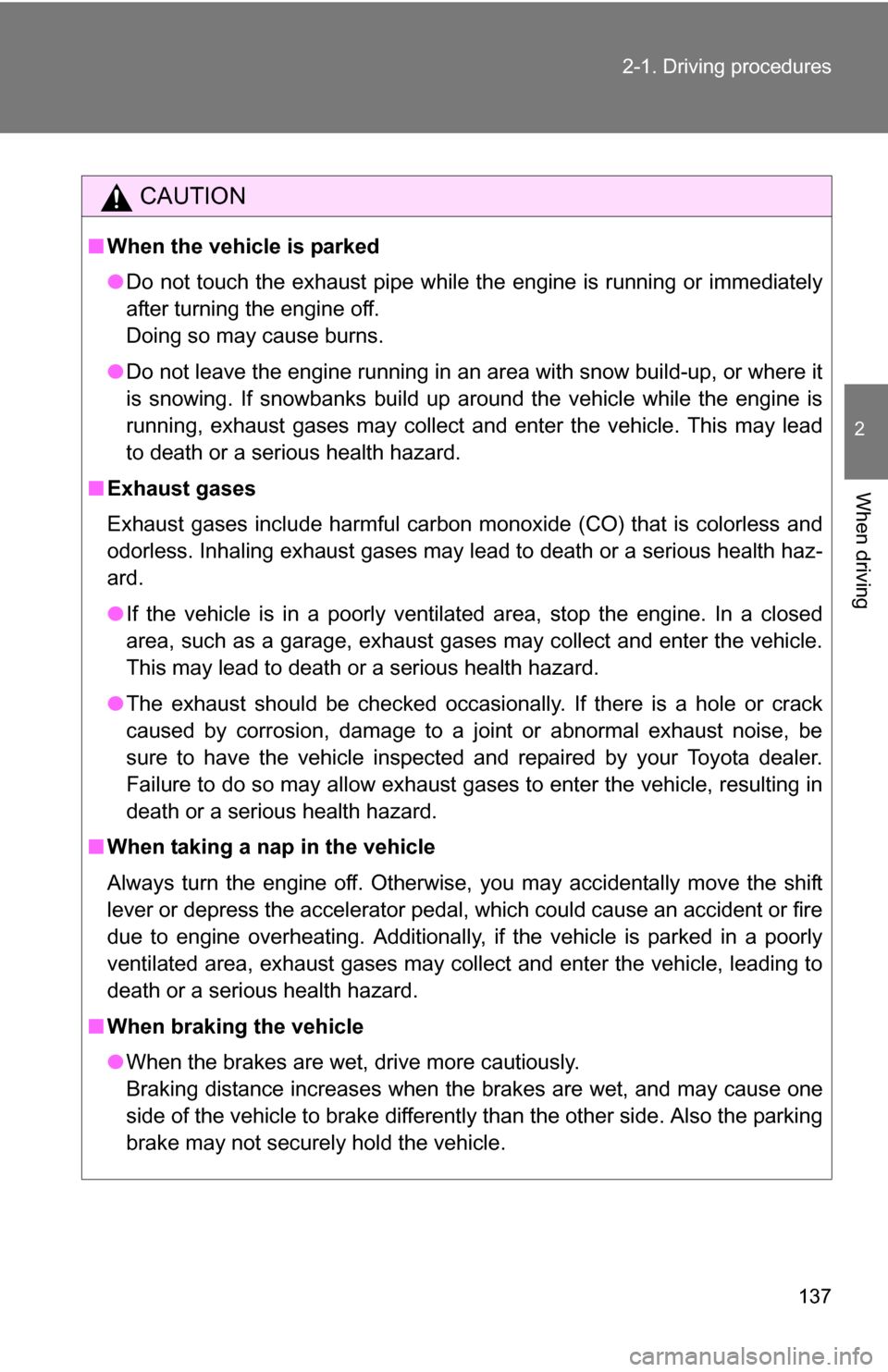
137
2-1. Driving procedures
2
When driving
CAUTION
■
When the vehicle is parked
●Do not touch the exhaust pipe while the engine is running or immediately
after turning the engine off.
Doing so may cause burns.
● Do not leave the engine running in an area with snow build-up, or where it
is snowing. If snowbanks build up around the vehicle while the engine is
running, exhaust gases may collect and enter the vehicle. This may lead
to death or a serious health hazard.
■ Exhaust gases
Exhaust gases include harmful carbon monoxide (CO) that is colorless and
odorless. Inhaling exhaust gases may lead to death or a serious health haz-
ard.
●If the vehicle is in a poorly ventilated area, stop the engine. In a closed
area, such as a garage, exhaust gases may collect and enter the vehicle.
This may lead to death or a serious health hazard.
● The exhaust should be checked occasionally. If there is a hole or crack
caused by corrosion, damage to a joint or abnormal exhaust noise, be
sure to have the vehicle inspected and repaired by your Toyota dealer.
Failure to do so may allow exhaust gases to enter the vehicle, resulting in
death or a serious health hazard.
■ When taking a nap in the vehicle
Always turn the engine off. Otherwise, you may accidentally move the shift
lever or depress the accelerator pedal, which could cause an accident or fire
due to engine overheating. Additionally, if the vehicle is parked in a poorly
ventilated area, exhaust gases may collect and enter the vehicle, leadin\
g to
death or a serious health hazard.
■ When braking the vehicle
●When the brakes are wet, drive more cautiously.
Braking distance increases when the brakes are wet, and may cause one
side of the vehicle to brake differently than the other side. Also the parking
brake may not securely hold the vehicle.
Page 146 of 520
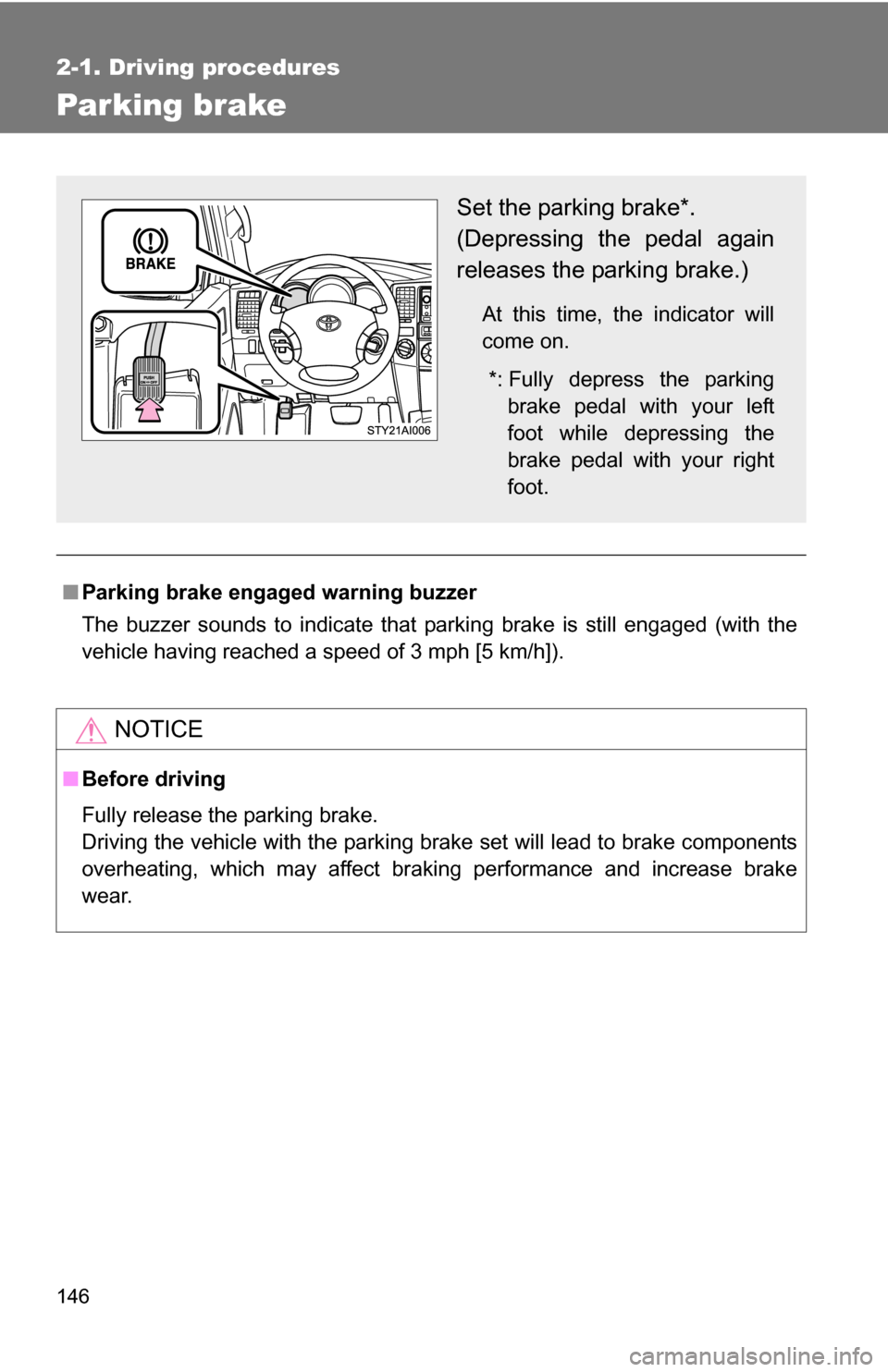
146
2-1. Driving procedures
Parking brake
■Parking brake engaged warning buzzer
The buzzer sounds to indicate that parking brake is still engaged (with the
vehicle having reached a speed of 3 mph [5 km/h]).
NOTICE
■Before driving
Fully release the parking brake.
Driving the vehicle with the parking brake set will lead to brake components
overheating, which may affect braking performance and increase brake
wear.
Set the parking brake*.
(Depressing the pedal again
releases the parking brake.)
At this time, the indicator will
come on.
*: Fully depress the parking brake pedal with your left
foot while depressing the
brake pedal with your right
foot.
Page 150 of 520

150 2-2. Instrument cluster
NOTICE
■To prevent damage to the engine and its components
●Do not let the indicator needle of the tachometer enter the red zone, which
indicates the maximum engine speed.
● The engine may be overheating if the temperature gauge is in the red
zone (H). In this case, immediately stop the vehicle in a safe place, and
check the engine after it has cooled completely. (
P. 463)
Page 222 of 520

222 2-5. Driving information
●Avoid sudden braking as you may skid, resulting in jackknifing and
loss of control. This is especiall y true on wet or slippery surfaces.
● Avoid jerky starts or sudden acceleration.
● Avoid jerky steering and sharp turns, and slow down before mak-
ing a turn.
● Note that when making a turn, th e trailer wheels will be closer than
the vehicle wheels to the inside of the turn. Compensate by making
a larger than normal turning radius.
● Crosswinds and rough roads will adversely affect handling of your
vehicle and trailer, causing sway . Periodically check the rear to
prepare for being passed by large trucks or buses, which may
cause your vehicle and trailer to sway. If swaying occurs, firmly grip
the steering wheel, reduce speed immediately but gradually, and
steer straight ahead. Never increase speed. If you make no
extreme correction with the stee ring or brakes, your vehicle and
trailer will stabilize.
● Take care when passing other v ehicles. Passing requires consider-
able distance. After passing a vehi cle, do not forget the length of
your trailer, and be sure you hav e plenty of room before changing
lanes.
● In order to maintain engine braking efficiency when driving on a
long steep downgrade, do not use the transmission in D.
Transmission shift position must be in 4.
● Due to the added load of the trailer, your vehicle’s engine may
overheat on hot days (at temper atures over 85°F [30°C]) when
driving up a long or steep grade. If the engine coolant temperature
gauge indicates overheating, immediately turn off the air condition-
ing (if in use), pull your vehicle off the road and stop in a safe spot.
( P. 463)
Page 335 of 520
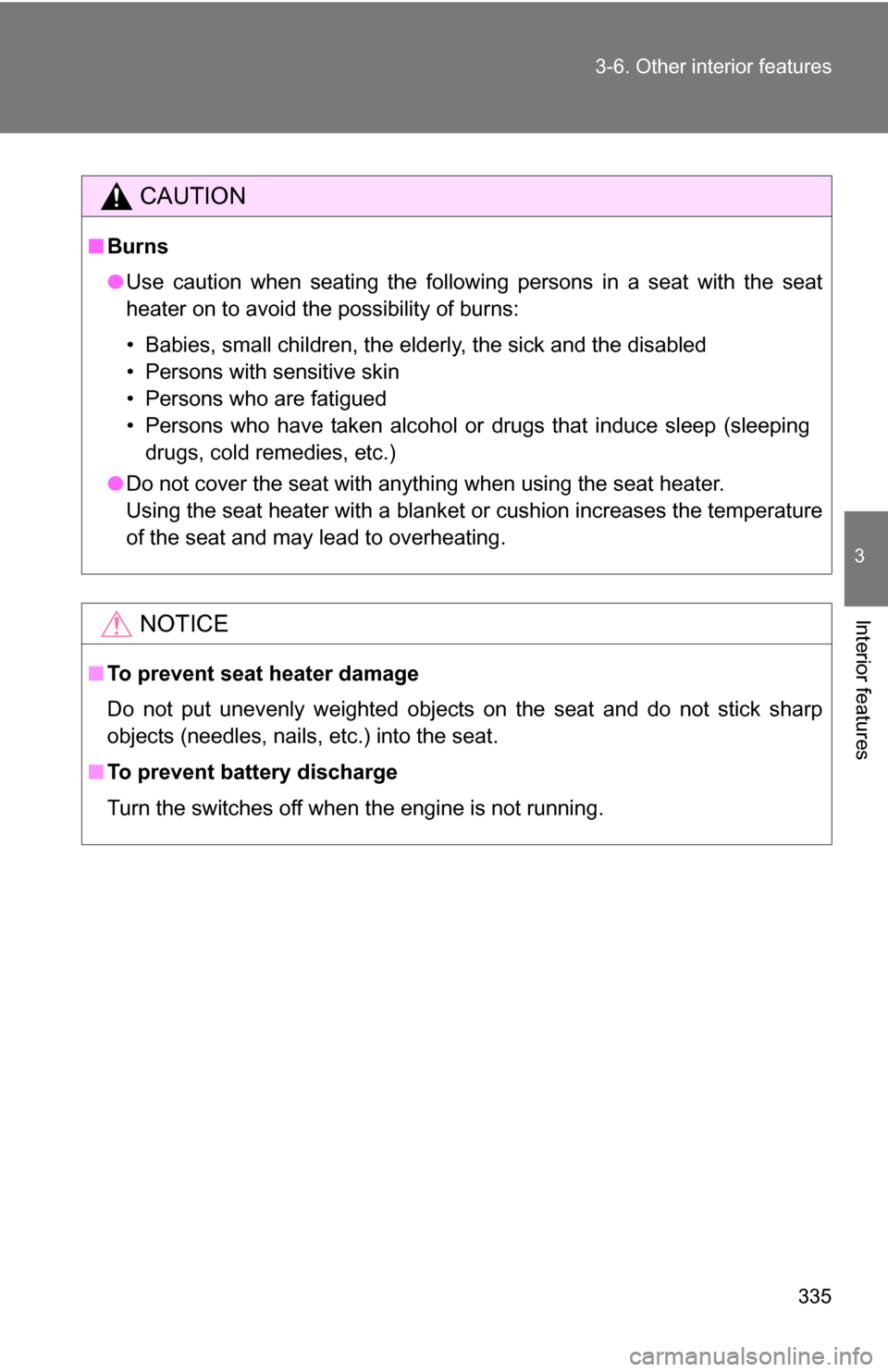
335
3-6. Other interior features
3
Interior features
CAUTION
■
Burns
●Use caution when seating the following persons in a seat with the seat
heater on to avoid the possibility of burns:
• Babies, small children, the elderly, the sick and the disabled
• Persons with sensitive skin
• Persons who are fatigued
• Persons who have taken alcohol or drugs that induce sleep (sleeping
drugs, cold remedies, etc.)
● Do not cover the seat with anything when using the seat heater.
Using the seat heater with a blanket or cushion increases the temperature
of the seat and may lead to overheating.
NOTICE
■To prevent seat heater damage
Do not put unevenly weighted objects on the seat and do not stick sharp
objects (needles, nails, etc.) into the seat.
■ To prevent battery discharge
Turn the switches off when the engine is not running.
Page 465 of 520
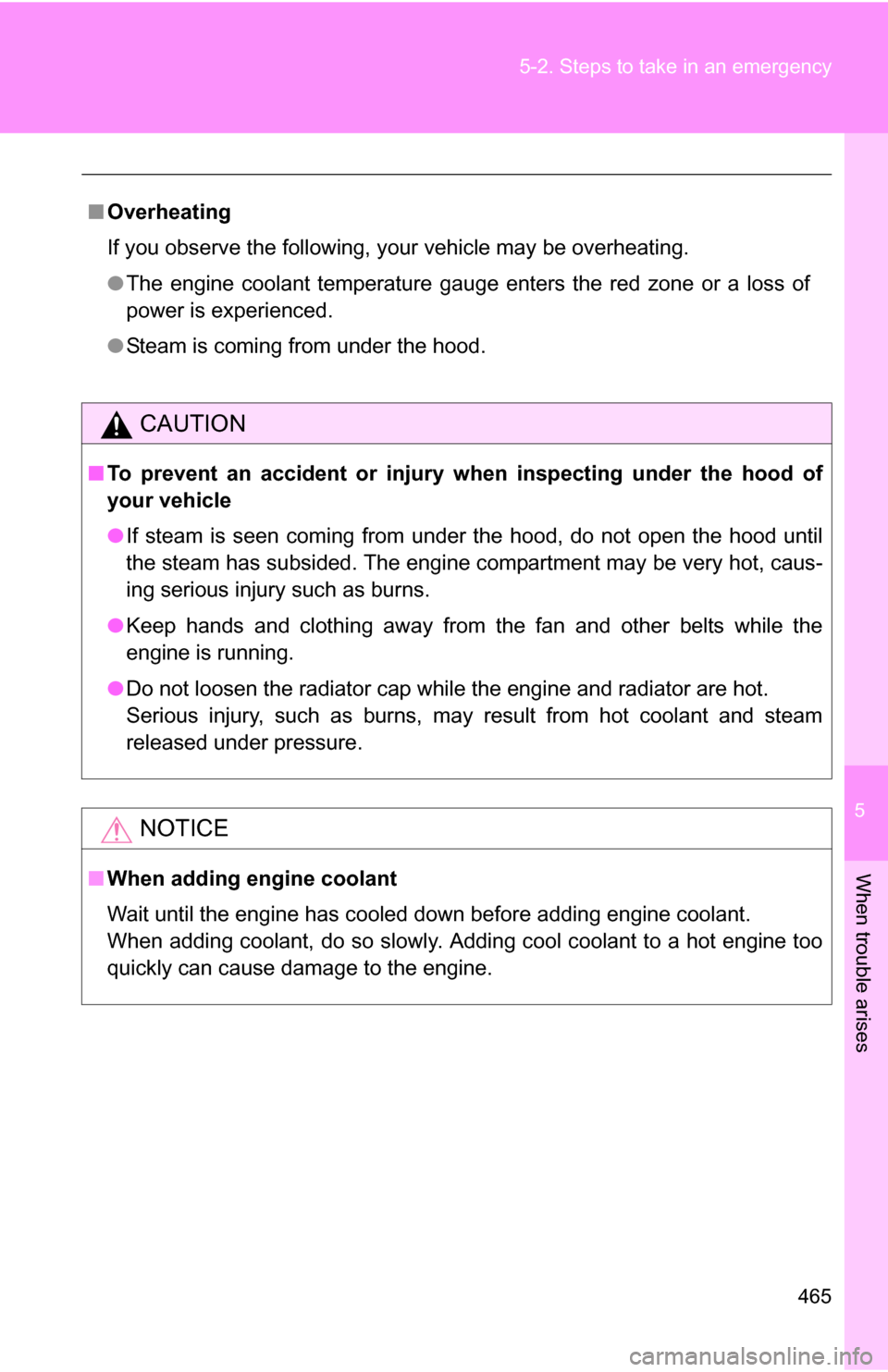
5
When trouble arises
465
5-2. Steps to take in an emergency
■
Overheating
If you observe the following, your vehicle may be overheating.
●The engine coolant temperature gauge enters the red zone or a loss of
power is experienced.
● Steam is coming from under the hood.
CAUTION
■To prevent an accident or injury when inspecting under the hood of
your vehicle
●If steam is seen coming from under the hood, do not open the hood until
the steam has subsided. The engine compartment may be very hot, caus-
ing serious injury such as burns.
● Keep hands and clothing away from the fan and other belts while the
engine is running.
● Do not loosen the radiator cap while the engine and radiator are hot.
Serious injury, such as burns, may result from hot coolant and steam
released under pressure.
NOTICE
■When adding engine coolant
Wait until the engine has cooled down before adding engine coolant.
When adding coolant, do so slowly. Adding cool coolant to a hot engine too
quickly can cause damage to the engine.
Page 507 of 520
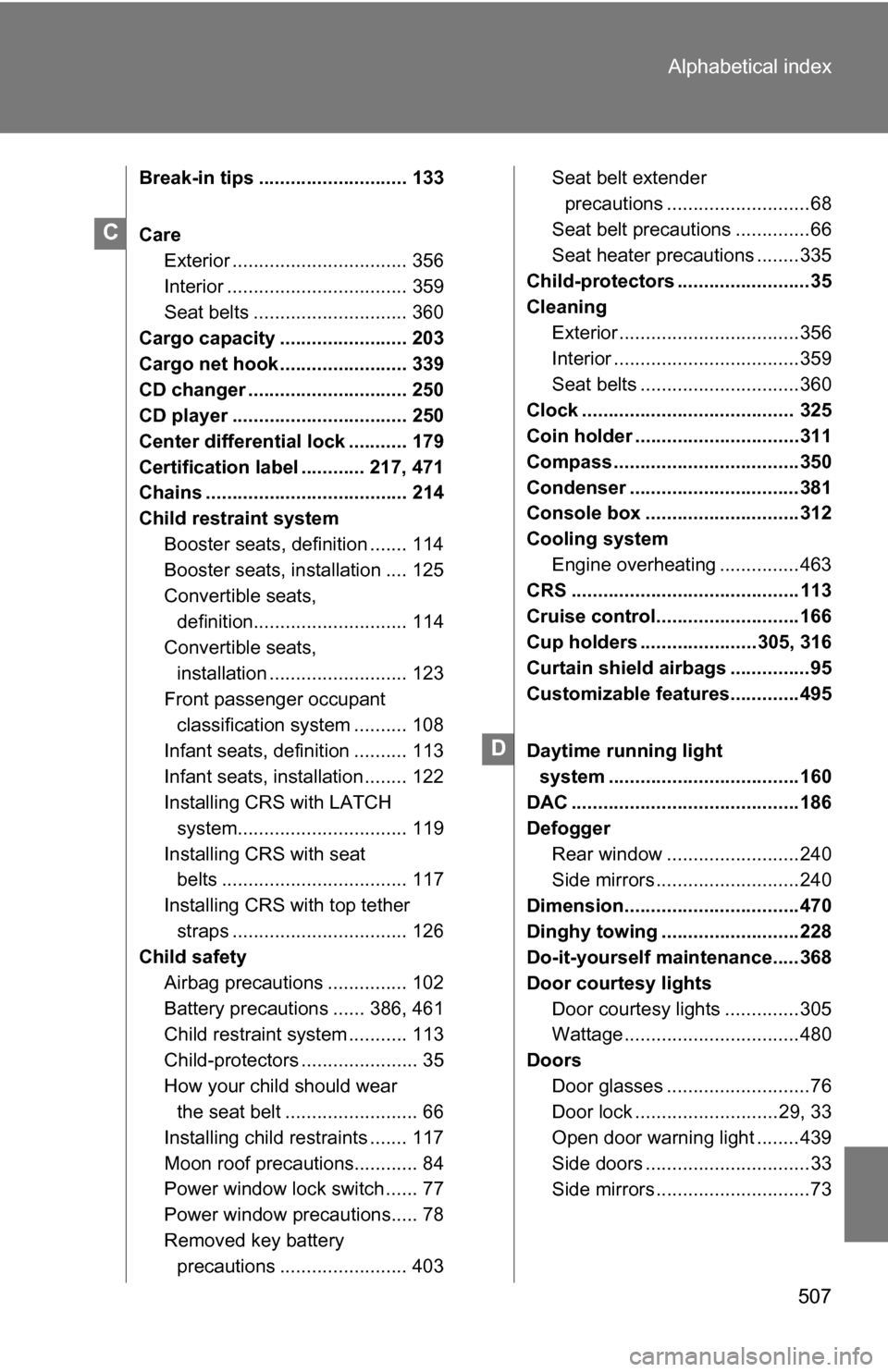
507
Alphabetical index
Break-in tips ............................ 133
Care
Exterior ................................. 356
Interior .................................. 359
Seat belts ............................. 360
Cargo capacity ........................ 203
Cargo net hook ........................ 339
CD changer .............................. 250
CD player ................................. 250
Center differential lock ........... 179
Certification label ............ 217, 471
Chains ...................................... 214
Child restraint system
Booster seats, definition ....... 114
Booster seats, installation .... 125
Convertible seats, definition............................. 114
Convertible seats,
installation .......................... 123
Front passenger occupant classification system .......... 108
Infant seats, definition .......... 113
Infant seats, installation ........ 122
Installing CRS with LATCH system................................ 119
Installing CRS with seat belts ................................... 117
Installing CRS with top tether straps ................................. 126
Child safety
Airbag precautions ............... 102
Battery precautions ...... 386, 461
Child restraint system ........... 113
Child-protectors ...................... 35
How your child should wear the seat belt ......................... 66
Installing child restraints ....... 117
Moon roof precautions............ 84
Power window lock switch ...... 77
Power window precautions..... 78
Removed key battery precautions ........................ 403 Seat belt extender
precautions ...........................68
Seat belt precautions ..............66
Seat heater precautions ........335
Child-protectors .........................35
Cleaning
Exterior ..................................356
Interior ...................................359
Seat belts ..............................360
Clock ........................................ 325
Coin holder ...............................311
Compass ...................................350
Condenser ................................381
Console box .............................312
Cooling system Engine overheating ...............463
CRS ...........................................113
Cruise control...........................166
Cup holders ......................305, 316
Curtain shield airbags ...............95
Customizable features.............495
Daytime running light
system ....................................160
DAC ...........................................186
Defogger
Rear window .........................240
Side mirrors ...........................240
Dimension.................................470
Dinghy towing ..........................228
Do-it-yourself main tenance.....368
Door courtesy lights Door courtesy lights ..............305
Wattage .................................480
Doors Door glasses ...........................76
Door lock ...........................29, 33
Open door warning light ........439
Side doors ...............................33
Side mirrors .............................73
C
D
Page 508 of 520

508 Alphabetical index
Downhill Assist Control .......... 186
Driver’s seat belt reminder buzzer ..................................... 439
Driver's seat belt reminder light ......................................... 439
Driving Break-in tips .......................... 133
Correct posture .......................93
Driving assist systems........... 188
Procedures ............................ 140
Winter driving tips.................. 213
Driving position memory...........58
DVD player ................................ 280
Electronically modulated air suspension............................. 169
Emergency, in case of If a warning buzzer sounds ................................ 436
If a warning light turns on ...... 436
If the engine will not start ...... 456
If the shift lever cannot be shifted from P...................... 457
If the vehicle battery is discharged .......................... 459
If the vehicle becomes stuck ................................... 466
If you have a flat tire ............. 445
If you lose your keys ............. 458
If you think something is wrong .................................. 432
If your vehicle needs to be towed .................................. 427
If your vehicle overheats ....... 463
Emergency flashers Switch.................................... 426
Engine
Compartment ........................ 373
Engine switch ........................ 140
Hood...................................... 372
How to start the engine ......... 140
Identification number ............. 472
If the engine will not start ...... 456 Ignition switch ....................... 140
Immobilizer system ................. 88
Overheating .......................... 463
Engine coolant Capacity ................................ 475
Checking ............................... 380
Preparing and checking before winter ....................... 213
Temperature gauge .............. 148
Engine coolan t temperature
gauge ...................................... 148
Engine immobilizer system ...... 88
Engine oil Capacity ................................ 474
Checking ............................... 375
Preparing and checking before winter .................................. 213
Warning light ................. 437, 439
Engine oil maintenance data ......................................... 378
Engine switch........................... 140
Event data recorder ................. 434
Floor mat .................................. 337
Fluid Brake..................................... 381
Washer.................................. 387
Fog lights
Replacing light bulbs ............. 417
Switch ................................... 162
Wattage................................. 480
Four-wheel drive system Four-wheel drive control switch.................................. 177
Front passenger occupant classification system ............ 108
Front passenger's seat belt
reminder light ........................ 439
Front passenger’s seat belt warning buzzer ...................... 439
Front seats Adjustment .............................. 41
E
F